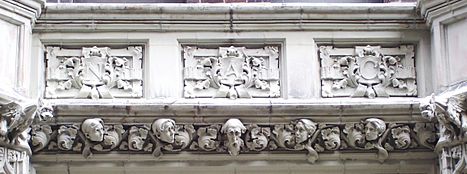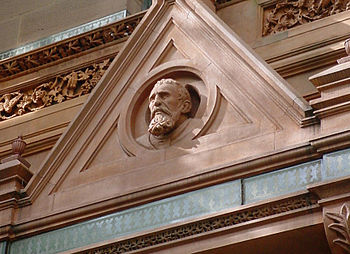- National Arts Club
-
Coordinates: 40°44′16″N 73°59′12″W / 40.737828°N 73.986617°W
The National Arts Club is a private club in Gramercy Park, New York City, New York, USA. It was founded in 1898 to "stimulate, foster, and promote public interest in the arts and to educate the American people in the fine arts". Since 1906 the organization has occupied the Samuel J. Tilden House, a landmark Gothic Revival brownstone at 15 Gramercy Park, immediately next door and West of the Players Club, with similar interests. The club offers a variety of shows, educational programs, and awards in areas including theater, visual arts, film, literature and music. It is noted for allowing members access to a Gramercy Park key.
Contents
Members
The National Arts Club is one of the few private clubs that has admitted women as full and equal members since its inception.
Among the distinguished painters who have been members are Robert Henri, Edward Charles Volkert, Frederic Remington, William Merritt Chase, Richard C. Pionk, Chen Chi and Cecilia Beaux. Sculptors have been represented by Augustus Saint-Gaudens, Daniel Chester French, Anna Hyatt Huntington and Paul Manship. Many renowned literary figures, including W. H. Auden, Mark Twain and Frank McCourt have been members.
The National Arts Club is proud of its early recognition of new media art forms, like photography, film and digital media, and counts Alfred Stieglitz as one of its early members. Musicians Victor Herbert and Walter Damrosch were members, as were architects Stanford White and George B. Post.
The Dramatic Arts are currently represented by members Martin Scorsese, Ethan Hawke, Dennis Hopper, Robert Redford and Uma Thurman, and the literary arts by such writers as Alice Hoffman and Edward Renehan. The membership of the National Arts Club has included three Presidents of the United States: Theodore Roosevelt, Woodrow Wilson, and Dwight Eisenhower.
The current president is painter and philanthropist Dianne Bernhard, who assumed the office in June, 2011. She succeeded O. Aldon James, who had run the organization since 1985.[1] No stranger to controversy, James was credited with revitalizing the organization and doubling the membership.[2] In the same period, however, there was a conviction for fraudulent use of the club's nonprofit tax identity by James's twin-brother John,[3] and another conviction for the theft of tax receipts by the club's dining room manager,[4] as well as a high-profile conflict with Gramercy Park trustees over the cutting of trees that the club sought to save,[5] and doubts aired in 2004 that the club's historic building was being properly maintained.[6]
History
The last decade of the 19th century saw a proliferation of clubs in New York City. A group of friends, all of them involved in architecture, art, or civic affairs, discussed the possibility of a new kind of club that would embrace all the arts. The establishment of the Club came at a time when American artists were increasingly turning to their own nation rather than exclusively to Europe as a center of work and creativity. Significantly, the Club would offer full membership for women at the onset, reflecting their accomplishment in the arts.
While the group was working out an organizational plan, Charles DeKay, the literary and art critic of the New York Times for 18 years, returned from a diplomatic post abroad. An inspired organizer and entrepreneur, he sent letters to men and women of importance in the New York area as well as in metropolitan areas across the country. The response was so enthusiastic that the Club was able to apply to Albany for its charter in 1898. With the application went a list of the officers, Board of Trustees, and members totaling more than 1200.
The list included such collectors as Henry Frick, William Evans, Benjamin Altman, Jules Bache and Henry Walters. Though not a charter member, J. Pierpont Morgan joined the Club early in its development and later was made an Honorary Vice President. Among the artists of the period, earlier charter members, or those joined in the early days of the Club were Frederic Remington, William Merritt Chase, Robert Henri and George Bellows.
The Club's first home was a brownstone on West 34th Street. Commerce, meanwhile, was moving up from downtown, and the neighborhood of brownstones was changing. Spencer Trask, its treasurer, was asked to find the Club a new home. He found that 14 and 15 Gramercy Park South, the former home of Samuel Tilden, was on the market. Legend has it that he was so afraid that some other buyer would also find it that he put down some money of his own to bind the bargain. In 1906, the Club acquired the Samuel J. Tilden House.
Since the Summer 2006, the Manson's stoop at 14 Gramercy Park has been under restoration. Recently, New York artist Sergio Rossetti Morosini has sculpted the bust of Michelangelo on its façade.
See also
References
- Notes
- ^ Robin Finn (2001-01-25). "A Patron of the Arts in a Courtroom Drama". The New York Times. http://query.nytimes.com/gst/fullpage.html?res=9C06E1D8163FF936A15752C0A9679C8B63&sec=&spon=&pagewanted=2.
- ^ Dinitia Smith (2001-06-13). "A Genteel Fellowship Turns Fractious; Money Matters Are Questioned At the National Arts Club". The New York Times. http://query.nytimes.com/gst/fullpage.html?res=9F0CE6D6103EF930A25755C0A9679C8B63.
- ^ Susan Saluny (2003-07-11). "Plea In Arts Club Case". The New York Times. http://query.nytimes.com/gst/fullpage.html?res=9506E4DB113DF932A25754C0A9659C8B63.
- ^ Hope Reeves (2002-10-09). "Arts Club Official Pleads Guilty". The New York Times. http://query.nytimes.com/gst/fullpage.html?res=9E0DE3D81E3BF93AA35753C1A9649C8B63.
- ^ Ann Raver (2005-05-19). "A 'Theydunit' in the Park". The New York Times. http://www.nytimes.com/2005/05/19/garden/19cutt.html.
- ^ Erika Kinetz (2004-05-02). "A Haven For Artists Faces Doubts At Home". The New York Times. http://query.nytimes.com/gst/fullpage.html?res=9E02E5D7143DF931A35756C0A9629C8B63&partner=rssnyt&emc=rss.
External links
- The National Arts Club (official website)
- Plea in Arts Club case, New York Times 2003-07-11
- A 'Theydunit' in the Park, New York Times 2005-05-19
- National Arts Club Records at the Smithsonian's Archives of American Art
Categories:- American artist groups and collectives
- Clubs and societies in the United States
- Culture of New York City
- Private clubs
- Traditional gentlemen's clubs in the United States
Wikimedia Foundation. 2010.




